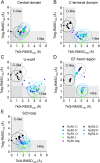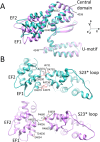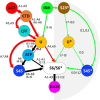Structure-based mechanism of RyR channel operation by calcium and magnesium ions
- PMID: 40300027
- PMCID: PMC12119028
- DOI: 10.1371/journal.pcbi.1012950
Structure-based mechanism of RyR channel operation by calcium and magnesium ions
Abstract
Ryanodine receptors (RyRs) serve for excitation-contraction coupling in skeletal and cardiac muscle cells in a noticeably different way, not fully understood at the molecular level. We addressed the structure of skeletal (RyR1) and cardiac (RyR2) isoforms relevant to gating by Ca2+ and Mg2+ ions (M2+). Bioinformatics analysis of RyR structures ascertained the EF-hand loops as the M2+ binding inhibition site and revealed its allosteric coupling to the channel gate. The intra-monomeric inactivation pathway interacts with the Ca2+-activation pathway in both RyR isoforms, and the inter-monomeric pathway, stronger in RyR1, couples to the gate through the S23*-loop of the neighbor monomer. These structural findings were implemented in the model of RyR operation based on statistical mechanics and the Monod-Wyman-Changeux theorem. The model, which defines closed, open, and inactivated macrostates allosterically coupled to M2+-binding activation and inhibition sites, approximated the open probability data for both RyR1 and RyR2 channels at a broad range of M2+ concentrations. The proposed mechanism of RyR operation provides a new interpretation of the structural and functional data of mammalian RyR channels on common grounds. This may provide a new platform for designing pharmacological interventions in the relevant diseases of skeletal and cardiac muscles. The synthetic approach developed in this work may find general use in deciphering mechanisms of ion channel functions.
Copyright: © 2025 Zahradníková et al. This is an open access article distributed under the terms of the Creative Commons Attribution License, which permits unrestricted use, distribution, and reproduction in any medium, provided the original author and source are credited.
Conflict of interest statement
The authors have declared that no competing interests exist.
Figures










Similar articles
-
Ca2+ stores regulate ryanodine receptor Ca2+ release channels via luminal and cytosolic Ca2+ sites.Clin Exp Pharmacol Physiol. 2007 Sep;34(9):889-96. doi: 10.1111/j.1440-1681.2007.04708.x. Clin Exp Pharmacol Physiol. 2007. PMID: 17645636 Review.
-
Calcium activation of ryanodine receptor channels--reconciling RyR gating models with tetrameric channel structure.J Gen Physiol. 2005 Nov;126(5):515-27. doi: 10.1085/jgp.200509328. J Gen Physiol. 2005. PMID: 16260840 Free PMC article.
-
Evidence for novel caffeine and Ca2+ binding sites on the lobster skeletal ryanodine receptor.Br J Pharmacol. 1999 Feb;126(4):1066-74. doi: 10.1038/sj.bjp.0702400. Br J Pharmacol. 1999. PMID: 10193789 Free PMC article.
-
Regulation of the RYR1 and RYR2 Ca2+ release channel isoforms by Ca2+-insensitive mutants of calmodulin.Biochemistry. 2003 Mar 11;42(9):2740-7. doi: 10.1021/bi0267689. Biochemistry. 2003. PMID: 12614169
-
Immunophilins and coupled gating of ryanodine receptors.Curr Top Med Chem. 2003;3(12):1383-91. doi: 10.2174/1568026033451907. Curr Top Med Chem. 2003. PMID: 12871170 Review.
Cited by
-
The Yin and Yang of Heartbeats: Magnesium-Calcium Antagonism Is Essential for Cardiac Excitation-Contraction Coupling.Cells. 2025 Aug 18;14(16):1280. doi: 10.3390/cells14161280. Cells. 2025. PMID: 40862759 Free PMC article. Review.
References
MeSH terms
Substances
LinkOut - more resources
Full Text Sources
Miscellaneous

